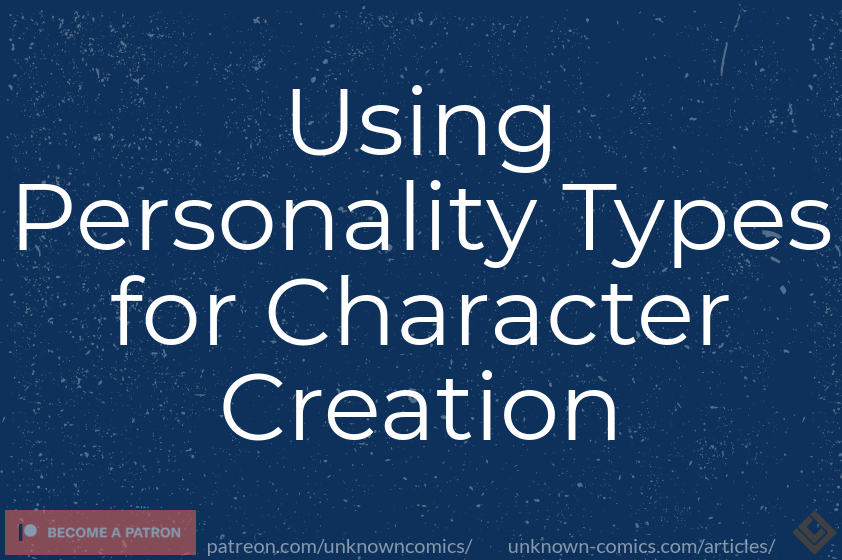Wow, this one is going to be pretty interesting! When I first learned about Myer Briggs and the 16 personalities the only thing I could think of was how great this would be if I implemented it into a preliminary comic scripting process for character creation (I know, such a nerd…). So let’s learn how we can use personality types for character creation!
This article will look into using a questionnaire inspired by Katharine Cook Briggs. Which was then made available by the wonderful people in 16personalities.com for determining personality types.
Then we will dive in and see just what characteristics you can discern from the results and how you can benefit from using it for developing a diverse cast of characters for your own comic book, graphic novel or manga.
So What Is The Myer Briggs 16 Personalities?
Before you begin reading this article I would strongly recommend you check out 16personalities.com. That is where I not only took the test to determine my own personality type but where I obtained a bulk of the information regarding this tool. All other ideas on how to use it for comics are my own.
How it Works
You start by taking a short test (they estimate it would take 12 minutes of your very valuable time). I would recommend filling it out as honestly as possible. This is supposedly who you are, no reason to lie to yourself (I even had to go back and review my own answers to make sure they were sincere).
After you complete your questionnaire you’ll be given a category, a role, a strategy and finally your key traits.
List of Categories
There are four main categories with four additional sub-categories.
I won’t be going into detail for all of them, but I figured you’d like a list. Everyone loves a good list!
They go a little like this.
- Analysts
- Architect
- Logician
- Architect
- Debater
- Diplomats
- Advocate
- Mediator
- Protagonist
- Campaigner
- Sentinels
- Logistician
- Defender
- Executive
- Consul
- Explorers
- Virtuoso
- Adventurer
- Entrepreneur
- Entertainer
Key Traits
In its simplest form, you can use this tool to at least figuring out what kind of key traits a certain individual has. These are broken down as such:
- Mind: Whether you’re more extraverted or Introverted.
- Energy: Whether you’re more intuitive or observant.
- Nature: Whether you’re more thinking or feeling.
- Tactics: Whether you’re more judgemental or prospective.
- Identity: Whether you’re more assertive or turbulent.
Get a Better Understanding
As interested as I am in this tool, I’m not here to discuss everything about it. We’re here to learn how to use personality types for character creation.
Instead, I would like to know more about how I can use it for character creation. With that said if you’re still interested in learning more about this tool, I recommend doing some more reading into the framework detailed in 16personalities.com.
From here on out, I’ll be going a little more into discussing the various categories, sub-categories, and the key traits that I’ve already listed and more. Be sure to also check out the different personality types page. Take some time and review each one if you’d like to get a deeper understanding of each individual sub-category.
How To Use Personality Types For Character Creation
Character Creation
One of the ways you can use personality types for character creation definitively create a diverse cast of characters for your comic.
Using this tool will hopefully help you properly create a cast of characters that will not act, think and feel the same way when facing the same scenario.
So let’s start with the order in which I would recommend you do things.
1. Decide on the Cast of Your Comic
Pick who will show up on your comic. These can be both the main and minor characters. Who are they? Friends, family, acquaintances, work peers; you decide.
Once you got this you may or may not have a character bio for these individuals. Do remember, depending on the length of your story, characters may change over time. They could have new characteristics develop or they may have shed some over time. It’s not unusual to have multiple character bio’s for a certain character.
2. Take The Personality Test For Each Of Your Characters
Now comes test time!
You can do this in whichever schedule you’d like. You can power through it all at once or take your time and do one a day (I’d be interested in seeing how people doing this in different schedules would affect results).
In the end, you’ll at least have a nice little pile of charts detailing certain key traits for each of your characters.
3. Compare Your Characters
I’d like to think that this is the fun part… But I’d imagine it to be the most frustrating.
At this point, you’d be able to see if you have any variation in your cast’s personality or if you’ve come up with X amount of characters that are basically the same person.
Don’t fret though, we aren’t done yet.
Like the article so far? Support the production of more articles like this one!
4. Rethink, or Drop
I would argue that you have three different realizations in front of you.
- You can’t create different characters (just kidding).
- You’ll have to rethink certain characters
- You’ll have to drop certain characters
Let’s just start with B.
Rethinking Your Characters
It can be difficult as a writer to take on a different perspective than the one you’re used to.
For me, the best suggestion I have for this is to act. Pretend as if you were your characters. Play out a scene in your head and act as if you were one of your characters and see how they would react, feel, and interact with a scene. This can help lead to some inspiration.
Dropping Your Characters
Sometimes it can as easy as realizing that you probably don’t need that one character.
You know the one, the one that’s just there, not really doing anything different than the rest.
Maybe you can drive a good enough story with 3 characters instead of 4.
Editing
Personality types can help the editing process in a way that’s quite different to just having a character bio.
With a personality type you can figure out how a character will react, think and feel about a specific scene.
Over time their actions, thoughts, and feelings may change if presented in the same scene.
It’s up to you to decide if this is because they learned to act, think or feel differently. Or if because they changed.
Do People Change?
This is diving far more into the philosophical and psychological than I first intended it to but let’s do it.
The reason why I’m bringing this up is that I’d like to cover the possible discussion of whether or not you should ever have more than one personality type for your character.
What does it mean to only have one personality type per character vs multiple personality types per character?
It begs to question whether or not your characters became someone else or if they learned how to overcome who they were to be able to accomplish their hopes and dreams or fail because they were unwavering in their ways or chose to do wrong (debatable if the former is the wrong choice as well).
If characters suddenly became someone else. I’d beg to question, how? If they did, then everything they ever did before that point would suddenly become meaningless.
Alternatively, you can have multiple character bio’s, which can determine a character’s virtues and habits at a particular point in time. We can change that over time with experience.
What This Means For Editing Comics?
Simply put, you have to use the personality type and the key traits to determine if the long-term changes to a character make sense.
Whether or not you believe a character’s personality can change over time (amnesia, brainwashing, multiple personality disorder, etc [all worth discussing individually]) you’ll have to use that current personality to determine if a character would struggle with a particular plot, or if they would have found it easy to handle.
One of my favorite examples of different personalities making or breaking a story is if you’d swap Othello with Hamlet. Othello would just kill Hamlet’s uncle in the first 5 minutes. There isn’t much of a story there.
Conclusion
There are quite a bit of personality type tests out there nowadays. Psychology as a field is advancing every day and things are looking more and more interesting because of it.
With an online tool like the one found in 16personalitites.com being as quick and easy to use. It can only benefit you as a writer to at least test it out and see how using personality types for character creation can help you. If you have 5 main characters it can take you roughly 1 hour of your time to try and flesh out all your character’s personality types (without reading each profile).
Doing this can only help make sure that you have an appropriately diverse cast of characters that will reliably and sensibly change over time depending on the plot that you develop for them (or not). Either way, you’ll want to create a plot that will always cause the character you’d want to develop to struggle with. Without struggle, you don’t have a story.
Jeez, I really got all existential with the discussion on whether people can change. I even presented some examples that could explain why a character’s personality would change.
Either way, there is no doubt in my mind that you can utilize personality types alongside character bio’s to build an incredible cast of characters that can only grow with time and experience. All that’ll be left now is for the writer to come up with new ways to make their characters struggle for our entertainment.
Sign Up For
The Unknown Times!
Content Updates
Website News
Recommended Reading
And More to Come!
*Once every two weeks!*
Liked the article? Become part of my Patreon Community!
About The Author

Phillip Allen
Writer, Editor, and Founder of Unknown Comics
Hello there! My name is Phillip Allen and I'm the writer, editor, and founder of Unknown Comics. I am an aspiring comic book creator. In an attempt to learn how to create my own comic I came to learn just how few reliable resources existed out there. From a few books and unhelpful websites I decided to focus my attention on researching and writing a resource for both myself and the rest of the comic creating industry. This website and and its content is the result of all of that hard work.
Sources
“Myers–Briggs Type Indicator.” Wikipedia, Wikimedia Foundation, 26 Sept. 2018, en.wikipedia.org/wiki/Myers%E2%80%93Briggs_Type_Indicator.
“Our Framework.” 16Personalities, www.16personalities.com/articles/our-theory.
“Personality Types.” 16Personalities, www.16personalities.com/personality-types.
“Psychological Types.” Wikipedia, Wikimedia Foundation, 3 Sept. 2018, en.wikipedia.org/wiki/Psychological_Types.

